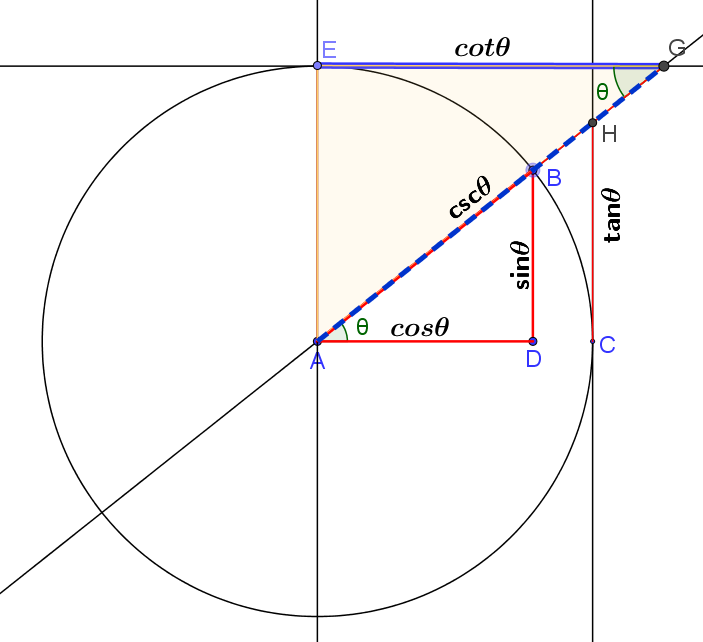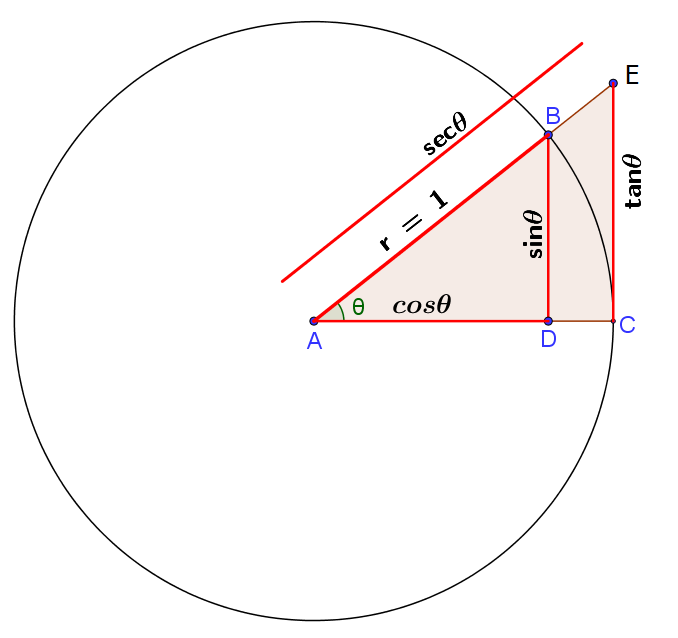More Definitions
This subsection just elaborates on the six fundamental trig functions and could be skipped without much loss of understanding.
Definition Cosine: The $x$-coordinate of the intersection between a ray from the origin and the unit circle, that is, the $x$-coordinate of a point on the unit circle. If we are looking for the cosine of an angle, $\theta$, and $0\le\theta\le2\pi$, then the angle is given counter-clockwise from the $x$-axis and the cosine is the $x$-coordinate intersection of a ray from the origin, drawn at angle $\theta$, and the unit circle.
Definition Sine: The $y$-coordinate of a point on the unit circle. The intersection between a ray from the origin and the unit circle. For an angle,$0\le\theta\le2\pi$, the sine is the $y$-coordinate intersection of a ray from the origin, drawn at angle $\theta$, and the unit circle.
Definition Tangent: The $y$-coordinate divided by the $x$-coordinate, for a ray from the center of the unit circle to any point on the unit circle.
These definitions are exact and will yield what a calculator or computer returns, and the values are often negative values.
Traditionally, these definitions for sine, cosine, and tangent were available from tables. Now, they are always computed as needed. Calculators and even some computers use the CORDIC , algorithm, which only involves addition, subtraction, bit shift, and to a minor extent some stored table data. {(Coordinate Rotation Digital Computer)J J O'Connor and E F Robertson. William Jones. Website of School of Mathematics and Statistics University of St Andrews, Scotland, JOC/EFR © February 2005 Available at: http://www-history.mcs.st-andrews.ac.uk/Biographies/Jones.html }
If high precision arithmetic is available, as in SAGE, then some very old methods will work satisfactorily, for example a power series. By the time the factorial value reaches $15$, $8$ terms in the sin series, there are at least $25$ digits of accuracy. The angle (x in the equations below) has to be in radians. $Rads=Degrees\cdot2\pi/360$.
These power series expressions are derived from Taylor Series. $$\sin(x)=x-\frac{x^{3}}{3!}+\frac{x^{5}}{5!}-\frac{x^{7}}{7!}+\frac{x^{9}}{9!}-...$$ $$\cos(x)=1-\frac{x^{2}}{2!}+\frac{x^{4}}{4!}-\frac{x^{6}}{6!}+\frac{x^{8}}{8!}-...$$ $$\tan(x)=x-\frac{x^{3}}{3}+\frac{x^{5}}{5}-\frac{x^{7}}{7}+\frac{x^{9}}{9}-...$$ Even though these summations can be easily put into code, nearly any machine that could run the code would already have these functions or we would want to consider faster and more powerful methods.
If we look at figure 1, we can visualize the lengths of inverse trig functions using a unit circle. The basic unit triangle is $ADB$. The definition for $\tan\theta$ for that triangle is $\frac{\sin\theta}{\cos\theta}=\frac{opp}{adj}$. The shaded triangle is similar to $ADB$, and its adjacent length is $AC=1$. Therefore, if $\tan\theta=\frac{opp}{adj}$ and $adj=1$, $\tan\theta=\frac{opp}{1}$. Therefore, $opp=\tan\theta$, as labeled.
Continuing with that pair of similar triangles, $$\sec\theta=\frac{1}{\cos\theta}=\frac{AB}{AD}\Longleftarrow \text{definition}$$ Also with the similar triangle, $$\sec\theta=\frac{AE}{AC}=\frac{AE}{1}$$ Therefore $\sec\theta=AE$ as labeled.
Looking at figure 2, the shaded triangle is again similar to the unit triangle, $ADB$, and is also similar to triangle $ACH$. Note that $\theta$ has relocated to the upper right. We already showed that distance $HC$ is equivalent to $tan\theta.$ $$\cot\theta=\frac{\cos\theta}{\sin\theta}=\frac{AC}{\tan\theta}=\frac{1}{\tan\theta}\Longleftarrow definition$$ By similar triangles ,$$\cot\theta=\frac{\cos\theta}{\sin\theta}=\frac{EG}{EA}=\frac{EG}{1}$$ Therefore, $\cot\theta=EG$, as labeled. And, $$\csc\theta=\frac{1}{\sin\theta}\Longleftarrow definition$$ By similar triangles, $$\csc\theta=\frac{1}{\sin\theta}=\frac{AB}{BD}=\frac{AG}{EA}=\frac{AG}{1}$$ Therefore, $\csc\theta=AG$, as labelled..

